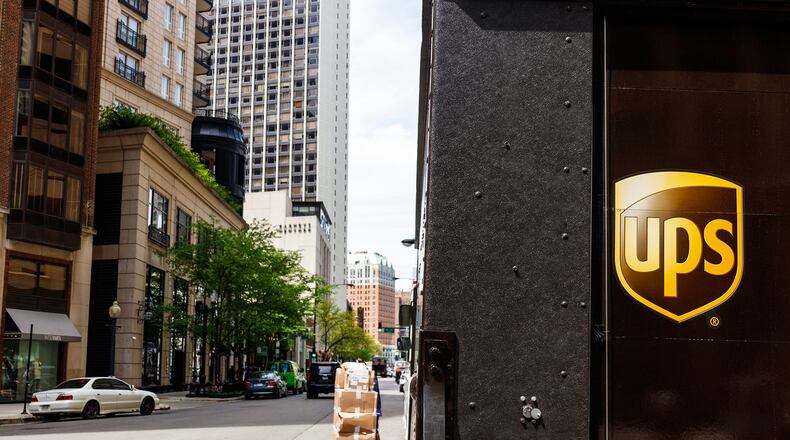A breakdown of contract negotiations between the Teamsters and Sandy Springs-based UPS on July 5 has prompted growing concerns about the possibility of a strike against the shipping giant.
The Teamsters’ current labor contract runs through July 31, and union officials have threatened to strike Aug. 1 if they haven’t reached a new deal with management by then.
That means only a few weeks remain for UPS and the Teamsters to come to an agreement and avoid a strike that would cripple the company and affect millions of packages and people across the country, with wide-reaching effects across the U.S. shipping industry — and the economy at large.
What could a strike against UPS mean for consumers and what’s at stake? Here’s a breakdown.
Will my package arrive on time?
If there’s a strike, consumers are expected to see more delivery delays and potentially higher shipping costs.
A UPS strike “would be painful,” said Satish Jindel, president of shipment technology firm ShipMatrix. “But not a disaster,” he predicted.
UPS says it has “contingency plans.” Industry experts expect the company would have non-union employees and managers step in to help deliver a portion of its regular volume. UPS also could turn to Roadie, the Atlanta-based company UPS acquired in 2021 that uses gig workers for deliveries, to step in to deliver some parcels to doorsteps, Jindel said. There’s no doubt that UPS would struggle to take on the volume of packages normally handled by hundreds of thousands of workers. Teamsters make up the majority of UPS’s more than 500,000 employees.
The strike threat “has enhanced nervousness” among retailers and other companies that need to ship items to customers, Jindel said.
Other carriers don’t have the capacity to take on the volume of packages that UPS would not be able to handle, according to Tommy Storch, a senior manager at Insight Sourcing Group.
“What consumers would see is delayed shipping times,” Storch said. If millions of packages per day can’t be shipped, the backlog would grow. “The longer a strike goes on, the longer it would take to unravel,” he said.
Businesses have been looking to alternatives to ship their products to customers, including UPS rival FedEx, the U.S. Postal Service and smaller regional carriers.
FedEx has already indicated that UPS customers have come calling.
The UPS labor negotiations have “opened a lot of doors,” said FedEx chief customer officer Brie Carere during remarks on financial results last month. “We’re having a lot of great conversations with legacy UPS customers, and we feel really good about the sales pipeline.” FedEx on Thursday posted on its website that companies considering shifting volume “are encouraged to begin shipping with FedEx now.”
Jindel said FedEx is asking new customers to commit to using its services for a longer period of time — or otherwise pay a penalty. That drives up shipping costs, he said.
How big is UPS?
UPS carries about 6% of the U.S. gross domestic product and 2% of world GDP daily.
The Teamsters have more than 340,000 members at UPS, making it the largest private collective bargaining agreement in North America.
Last year, UPS delivered an average of 24.3 million packages a day worldwide. That includes about 18.5 million packages handled domestically, according to Jindel, which would be affected by a Teamsters strike.
How would small businesses get items to customers?
If there is a strike, small businesses should be prepared to drop them off at the post office or with FedEx, Jindel said.
The U.S. Postal Service can handle millions more packages per day — but the problem is that it’s best suited for packages that can fit in a mailbox, he said.
If there is a UPS strike, he added, the ideal would be for retailers and other companies to use the Postal Service for small, lightweight items and FedEx for larger packages.
What was the 1997 strike like?
The only strike in UPS history was in 1997, when 185,000 Teamsters members walked out for 16 days.
In 1997, UPS controlled close to 80% of the small package delivery market, and the strike paralyzed commerce nationally. It cost the company $750 million in lost revenue and had lasting effects on the business
The shipping industry is very different now, with varying effects.
Now, UPS handles millions more packages a day. But its share of the delivery market is now closer to 35-40%, Jindel said.
That’s because FedEx has expanded its ground operation and became much larger, Amazon has its own delivery operation to handle a large share of its packages, and the Postal Service after seeing a decline in mail volume has increased its parcel capacity, according to Jindel.
Technology also now makes it easier for replacement workers to step in, he said. UPS hubs have more technology to quickly onboard new package handlers, and drivers have devices that can give them turn-by-turn directions to every address, for example.
What are the sticking points?
The Teamsters union in recent weeks cited significant progress in labor talks with UPS.
But after negotiations broke down Wednesday, International Brotherhood of Teamsters General President Sean O’Brien said one of the key sticking points was pay for part-time workers — who make up the majority of the Teamsters members at UPS.
Currently, UPS says its part-time union employees’ pay starts at $16.20 an hour, and they can work 3.5 hours or more each workday.
“There’s unsung heroes in those (UPS) facilities — part-timers,” O’Brien said on NPR on Friday. “These part-timers are working at poverty wages.”
“When we got into the negotiations over the part-timers, UPS simply said there’s no more to give,” O’Brien said on NPR. “They need to drive the starting wage rate up, reward the people that have been there a long time and provide full-time opportunity for these folks.”
UPS says on its website that part-time roles are critical to its business and says its compensation package for part-time workers includes “competitive hourly wages,” healthcare benefits, pension, tuition reimbursement and opportunity for advancement.
“We’re proud of what we’ve put forward in these negotiations, which deliver wins for our people,” UPS said in a written statement. “The Teamsters should return to the table to finalize this deal.”
About the Author
Keep Reading
The Latest
Featured




